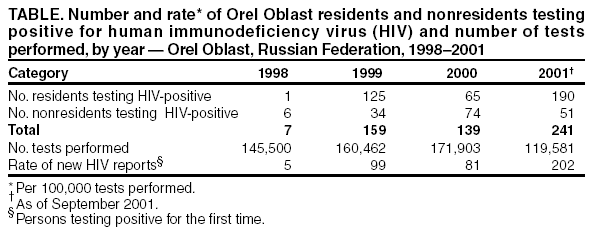 |
|
|
|
|
|
|
| ||||||||||
|
|
|
|
|
|
|
||||
| ||||||||||
|
|
|
|
|
Persons using assistive technology might not be able to fully access information in this file. For assistance, please send e-mail to: mmwrq@cdc.gov. Type 508 Accommodation and the title of the report in the subject line of e-mail. Rapid Increase in HIV Rates --- Orel Oblast, Russian Federation, 1999--2001During 1999--2001, the estimated number of cases of human immunodeficiency virus (HIV) reported officially in the Russian Federation increased approximately 16-fold, from 11,000 to 177,000 (1). In 2001, of 49,434 HIV-infected persons for whom a risk factor was identified, 46,274 (94%) were injection-drug users (IDUs) (1). However, the actual number of HIV-infected persons in Russia is estimated to be four to 10 times higher than reported (2; Russian Federal Center for Prevention of AIDS, unpublished data, 2002). Rapid increases in HIV have been reported in urban areas (e.g., Kaliningrad, Moscow, and St. Petersburg) (3) and also might be occurring in rural areas. During 1997--2000, HIV seroprevalence reportedly increased 33-fold in Orel Oblast, a predominantly rural, agricultural province (1999 population: 900,000) in central European Russia (Figure) (4). To confirm and describe this increase and evaluate the risk for continued rapid increase of HIV, CDC collaborated with the Orel Oblast AIDS and Infectious Diseases Prevention Center (AIDS Center) to assess recent HIV trends and the prevalence of risk behaviors among IDUs in Orel Oblast. This report summarizes the results of that assessment, which indicate continued increases in HIV rates and underscore the need for interventions directed at IDUs and their sex partners to limit further spread of HIV. During 1987--2001, the AIDS Center recorded results of all HIV tests (annual range: 140,000--170,000) and confirmed all HIV-positive tests for Orel Oblast residents and nonresidents. Voluntary routine HIV testing was offered to patients at drug-treatment, sexually transmitted disease (STD), tuberculosis (TB), and prenatal clinics; HIV testing was mandatory for prisoners. Because HIV reporting was name-based and confidential, persons testing positive were included only once. The AIDS Center collected clinical, HIV-risk, and contact histories for HIV-positive residents of Orel Oblast and offered HIV testing to recent sex and injection-drug using contacts of HIV-positive residents. During spring 2001, HIV-negative IDUs attending the drug-treatment clinic in Orel City were asked by clinic staff to complete an anonymous, self-administered survey on injection and drug-use practices. During 1998--2001, the annual rate of new positive HIV test results increased from five per 100,000 tests performed to 202 (Table). Testing patterns (i.e., populations tested and number of tests performed) remained stable during this time. Rates of prevalence of HIV infection were highest in Orel City and Mtsensk (64 and 181 per 100,000 population, respectively). The majority of IDUs were males aged 15--29 years; the combined age-adjusted prevalence of HIV among males aged 15--29 years in these two cities was <1%. During 1987--1998, eight Orel Oblast residents were identified as HIV-positive. During January 1999--September 2001, a total of 380 Orel Oblast residents were identified as HIV-positive; 312 (82%) were male, 341 (90%) were aged <30 years, and 313 (82%) were IDUs. A total of 62 (16%) were identified through contact investigation. During January 1999--September 2001, the number of new cases among women increased from 15 (12%) of 125 cases in January 1999 to 42 (22%) of 190 cases in September 2001. During January 1987--September 2001, a total of 33 (47%) of 70 women and 30 (9%) of 318 men probably were infected through having heterosexual sex. Of the 63 persons probably infected through heterosexual sex, 31 (49%) had sexual contact with persons known by the AIDS Center to be IDUs. Although precise data were not available, the majority of these cases occurred during 1999--2001. During January--September 2001, among 802 tests performed on IDUs at the main drug-treatment center, 52 (6%) persons were HIV-positive. As of September 2001, of an estimated 2,700 IDUs (one third of the estimated number of IDUs residing in Orel Oblast) tested through either the drug-treatment or penal system, 313 (12%) were HIV-positive (AIDS Center, unpublished data, 2001). All HIV care and treatment for Orel Oblast residents is provided at the AIDS Center clinic. As of September 2001, none of the 331 persons followed at the clinic who were HIV-positive had signs or symptoms consistent with CDC's case definition of AIDS (5). During January 1987--September 2001, three persons who were HIV-positive were identified with active TB despite a high community TB prevalence (211 cases per 100,000 population) in Orel Oblast (Orel Tuberculosis Dispensary, unpublished data, 2000) and routine HIV screening for all TB patients. Orel City drug-treatment clinic staff surveyed HIV-negative IDUs to assess their risk for contracting HIV. Of 110 HIV-negative IDUs who were surveyed about their drug use and injection practices, 88 (80%) were male, 97 (88%) were aged <30 years, and 105 (95%) injected heroin. Reported high-risk injection behaviors were frequent: 65 (59%) shared needles at least occasionally, and 68 (62%) purchased drugs already mixed in solution and thus potentially contaminated with HIV during mixing or sale. Of the 110 IDUs surveyed, 102 (93%) reported no difficulty acquiring unused needles, which are available legally without prescription at local pharmacies. Reported by: V Molotilov, MD, R Sofronova, MD, N Gusseynova, MD, N Laricheva, MD, AIDS and Infectious Diseases Prevention Center, Orel Oblast, Russian Federation. SL Hader, MD, R Garfein, PhD, L Paxton, MD, Div of HIV/AIDS Prevention, National Center for HIV, STD, and TB Prevention, CDC. Editorial Note:The findings in this report confirm recent increases in HIV in Orel Oblast, affecting primarily young male IDUs. The high prevalence of needle sharing and other unsafe injection practices among HIV-negative IDUs suggests continued rapid spread of HIV among this population. Continued spread of HIV from IDUs to their sex partners who do not inject drugs also is likely to continue in Orel Oblast unless further interventions to reduce transmission succeed. Since 2001, when this investigation was completed, approximately one fourth of new HIV cases reported in Orel Oblast have occurred in women whose infections resulted reportedly from heterosexual transmission (AIDS Center, unpublished data, 2003), indicating that an epidemiologic transition to transmission of HIV among heterosexual non-IDUs might be under way. Rates of injection-drug use, STDs, and TB in Russia are high (2,4,6). An estimated 1%--2% of the population inject drugs (2). The majority of IDUs are young men, and an estimated 5%--8% of men aged <30 years have injected drugs. Infection of a substantial proportion of young IDUs and their sex partners could have a substantial impact on social and economic conditions in the Russian Federation. The high rates of STDs (e.g., syphilis, which peaked in 1997 at 277 cases per 100,000 population) suggest that HIV could spread rapidly within sexual networks (6). In addition, in other countries with high endemic rates of TB, rising HIV rates have led to explosive growth in TB despite TB-control efforts (7). The findings in this report are subject to at least two limitations. First, although the total number of tests was known, the total number of IDUs tested was not available. As a result, HIV prevalence rates could only be estimated. Second, the number of tests among IDUs tested at the main drug-treatment center during 2001 who were HIV-negative included tests for persons who had multiple HIV-negative tests, some of whom were tested three to four times per year. As a result, HIV prevalence estimates in this report probably are underestimated. All HIV testing information is centralized at the AIDS Center. Although standard surveillance data do not routinely record the number of persons tested, minimal supplemental surveillance activities (e.g., computerization of testing information from all or sentinel sites to identify repeat HIV-negative testers) would allow routine calculation of true prevalence. Additional outreach to assess prevalence among IDUs and to identify interventions for IDUs not in contact with treatment or penal systems ("out-of-system IDUs") also might be useful. HIV-prevention interventions targeted at IDUs are needed that encourage cessation of drug use and build skills for safer injection and sex practices. In some communities, needle exchange programs have provided access to out-of-system IDUs, serving to deliver information on HIV prevention and drug treatment and to reduce risk behaviors (8,9). However, because unused needles can be acquired without difficulty in Orel Oblast, the AIDS Center and CDC are exploring other approaches to enhance access to out-of-system IDUs, including initiation of street-based peer outreach to IDUs and community-based "12-step" programs that encourage cessation of drug use and increase IDUs' understanding of safer injection and sex practices. The review of clinical data indicated that as of September 2001, few HIV-infected persons in Orel Oblast had signs of symptomatic HIV disease, and none were living with AIDS. However, clinical care needs will necessarily increase with disease progression. A well-established infrastructure exists for delivering care through the AIDS Center, providing a strong basis for additional interventions. Because community TB rates are high, isoniazid preventive TB therapy for HIV-infected persons should be considered; this strategy reduces morbidity and might limit the impact of HIV on local TB-control efforts (10). In addition, funding and partnerships should be pursued to support increased availability of monitoring tests, prophylactic medications for opportunistic infections, and affordable antiretroviral medications. To limit further increases of HIV in Orel Oblast, particularly among IDUs and their sex partners, local HIV-prevention activities should be enhanced. Because Orel Oblast is typical of many predominantly rural provinces in central European Russia (e.g., comparable population distribution, recent increase in injection-drug use and HIV reports, and the existence of a centralized AIDS center coordinating a network of services for the entire oblast), successful interventions in Orel might provide a model for interventions elsewhere in Russia. References
Table  Return to top. Figure  Return to top.
Disclaimer All MMWR HTML versions of articles are electronic conversions from ASCII text into HTML. This conversion may have resulted in character translation or format errors in the HTML version. Users should not rely on this HTML document, but are referred to the electronic PDF version and/or the original MMWR paper copy for the official text, figures, and tables. An original paper copy of this issue can be obtained from the Superintendent of Documents, U.S. Government Printing Office (GPO), Washington, DC 20402-9371; telephone: (202) 512-1800. Contact GPO for current prices. **Questions or messages regarding errors in formatting should be addressed to mmwrq@cdc.gov.Page converted: 7/17/2003 |
|||||||||
This page last reviewed 7/17/2003
|